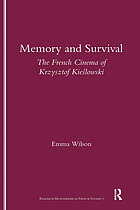
Critical film theory questions the basic premises behind power differentials in class, gender, and race by deconstructing films. Critical film theorists embrace numerous approaches, including Marxist, feminist, queer, and race. Krzysztof Kieślowski draws the eye of the critical theorist with three works. In The Fright of Real Tears: Krzysztof Kieślowski between Theory and Post-Theory, Slavoj Žižek uses Kieślowski’s work to take a critical stance and argue against postmodernist theories. In Memory and Survival: The French Cinema of Krzysztof Kieślowski, Emma Wilson deconstructs his work, paying particular attention to time-image and to trauma theory, to defend his French films. And in The Films of Krzysztof Kieślowski: The Liminal Image, Joseph Kickasola explores spiritual themes in the context of Kieślowski’s life and Poland’s history to argue that the liminal is a dialectic of immanence and transcendence. The idea of the “other” is a common theme in critical theory—John Drabinski deconstructs eight Jean-Luc Godard films to explore the idea of the other in Godard between Identity and Difference.
Feminist film theory analyzes film through a critical feminist lens. The critical feminist approach seems little used in world cinema outside the United States. Kaja Silverman and Harun Farocki take an avant-garde approach in Speaking about Godard (framed as an imaginary conversation with the filmmaker himself) to read eight Jean-Luc Godard films for feminist themes. In The Films of Ingmar Bergman: Illusions of Light and Darkness, Laura Hubner examines his work through a feminist lens, focusing on the multiple and complex identities of women. Susan White presents a political and feminist study of women’s role in society in The Cinema of Max Ophüls: Magisterial Vision and the Figure of Women. Kathleen Anne McHugh offers a close feminist reading on issues of female self-expression, relationships, and gender roles in Jane Campion. In The Cinema of Lars von Trier: Authenticity and Artifice, Caroline Bainbridge explores issues of authenticity and artifice by contrasting the Dogme 95 manifesto with the affectation of von Trier’s films. Though primarily a feminist exploration of issues of spectatorship and trauma, Bainbridge’s book also views von Trier’s work through psychoanalytic and critical lenses to argue ultimately that his work earns him auteur status.
Queer film theory challenges socially constructed gender norms and is often—though not always and not exclusively—applied to gay and lesbian filmmakers. Our list is no exception, with three monographs on Derek Jarman and one on Pier Paolo Pasolini. In The Films of Derek Jarman, William Pencak takes a historical perspective, using Jarman’s words and writings and production notes to glean his intention to reclaim history for gay people in order to inspire gay rights activists in his time. In Derek Jarman, Rowland Wymer uses queer theory to make a somewhat biographical film-by-film exploration of his works. In The Queer Cinema of Derek Jarman: Critical and Cultural Readings, Niall Richardson rewrites his dissertation to “examine how Jarman’s images explore many of the debates in current queer theory—especially its challenge to fixed ideas of gender, sexuality and the body.” In Pier Paolo Pasolini: Cinema as Heresy, Naomi Greene argues that Pasolini’s films began as a reflection of the social and political climate in Italy and his uneasiness with the Italian Communist Party but evolved to become radical portrayals of scandalous love as a metaphor for homosexuality. Geoffrey Nowell-Smith, in a mostly auteur analysis in Luchino Visconti, adds a section in his third edition that takes a retrospective look at how Visconti’s bisexuality informed his films.
In contrast to its position in American film analysis, critical race theory is virtually nonexistent as a form of criticism of world filmmakers, perhaps because race plays a lesser role in other countries. The most closely related theoretical concept is postcolonial film theory, a critical theory that explores the legacy of colonialism on the colonized. It is represented by Keya Ganguly’s use of the works of Theodor Adorno to conduct a postcolonial examination in Cinema, Emergence, and the Films of Satyajit Ray; Ganguly comes to the conclusion that history meets modernity in Ray’s films.
 The fright of real tears : Krzysztof Kieślowski between theory and post-theory
by
The fright of real tears : Krzysztof Kieślowski between theory and post-theory
by
 Memory and survival: The French cinema of Krzysztof Kieślowski
by
Memory and survival: The French cinema of Krzysztof Kieślowski
by
 The cinema of Lars von Trier: Authenticity and artifice
by
The cinema of Lars von Trier: Authenticity and artifice
by